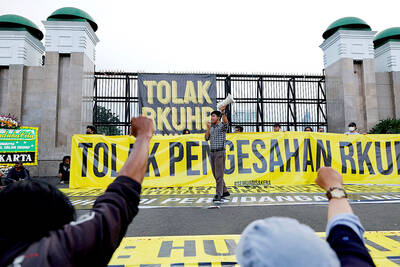On Monday, one year and a day after becoming prime minister of India, Manmohan Singh traveled to Ranthambore National Park, the celebrated sanctuary of India's national animal: the tiger.
The visit to Ranthambore Tiger Reserve was less a warm and fuzzy photo opportunity than an attempt to take on a budding political crisis. The tiger, as endangered worldwide as it is iconic in this country, is vanishing from India's tiger parks.
With a growing and lucrative market for everything tiger -- from skin to bone to the tiger's penis, used in Chinese traditional medicine -- tiger poachers have evidently had a run on several government-protected parks. A handful of poaching networks have been nabbed here in the capital in recent months, and their bundles of carefully tanned tiger skins displayed to a news media hungry for as much tiger-poaching copy as possible.
Most startling of all, a federal law enforcement inquiry found earlier this month that there was not a single tiger left at another famous Indian tiger reserve, called Sariska. At least two or three poaching networks were operating in the park, the probe found, and it raised the possibility of collusion by forest guards. Even in Ranthambore, the jewel in India's tiger sanctuary crown, 18 tigers have gone missing, according to press reports.
In fact, the tiger is among several endangered species that are in peril across the country, largely because of pressures on land and water. But the tiger, because of its symbolic potency, is the one that has seized the imagination of the country and now caught the prime minister's attention.
"Reports of the decline in the tiger population have once again alerted us to this grim reality," Singh said in a speech in April, adding, "Our government will take all the required steps to protect the tiger and other endangered species."
Singh ordered the federal investigation into Sariska. He appointed a so-called Tiger Task Force to draft a conservation policy. Earlier this year, a meeting of the National Board of Wildlife, which he chairs, was convened for the first time in 17 months. His office has even dangled the possibility of creating a special law enforcement unit assigned to wildlife protection.
India is a signer of the Convention on International Trade of Endangered Species, and it stands to face punitive measures should it fail to do its part to curb the illegal trade in tigers.
The Tiger Task Force called last Thursday for tougher measures to control poaching. Also last week, figures from the environment ministry showed that at least 122 tigers had been killed in the country's sanctuaries between 1999 and 2003; another 62 succumbed to what the government called "unnatural deaths."
"From a law enforcement perspective, it can't get any more serious," said John Sellar, a senior enforcement officer from the convention on trade of endangered species.
"You're talking about a highly endangered species," he said.
No one really knows how many tigers are left in India. The environment ministry estimates more than 3,600 tigers in its 28 tiger reserves, though tiger advocates angrily refute their claims. A tiger census is under way in several national parks.
Today, of India's 28 reserves, at least five are in trouble, according to one of the country's most vocal tiger champions, Belinda Wright, of the Wildlife Protection Society of India.
"It's an international scandal," she said. "I think that's why the prime minister is sitting up a little bit."
Circling around the vanishing tigers story in India is the question of what happens to the people who live around the tigers, namely the villagers who stand to gain vast sums of money by aiding poachers. In a statement, the Tiger Task Force said that among the failures in conservation was the "increasing hostility of local communities who share the tiger's habitat."

Shamans in Peru on Monday gathered for an annual New Year’s ritual where they made predictions for the year to come, including illness for US President Donald Trump and the downfall of Venezuelan President Nicolas Maduro. “The United States should prepare itself because Donald Trump will fall seriously ill,” Juan de Dios Garcia proclaimed as he gathered with other shamans on a beach in southern Lima, dressed in traditional Andean ponchos and headdresses, and sprinkling flowers on the sand. The shamans carried large posters of world leaders, over which they crossed swords and burned incense, some of which they stomped on. In this

Indonesia yesterday began enforcing its newly ratified penal code, replacing a Dutch-era criminal law that had governed the country for more than 80 years and marking a major shift in its legal landscape. Since proclaiming independence in 1945, the Southeast Asian country had continued to operate under a colonial framework widely criticized as outdated and misaligned with Indonesia’s social values. Efforts to revise the code stalled for decades as lawmakers debated how to balance human rights, religious norms and local traditions in the world’s most populous Muslim-majority nation. The 345-page Indonesian Penal Code, known as the KUHP, was passed in 2022. It

‘TRUMP’S LONG GAME’: Minnesota Governor Tim Walz said that while fraud was a serious issue, the US president was politicizing it to defund programs for Minnesotans US President Donald Trump’s administration on Tuesday said it was auditing immigration cases involving US citizens of Somalian origin to detect fraud that could lead to denaturalization, or revocation of citizenship, while also announcing a freeze of childcare funds to Minnesota and demanding an audit of some daycare centers. “Under US law, if an individual procures citizenship on a fraudulent basis, that is grounds for denaturalization,” US Department of Homeland Security Assistant Secretary Tricia McLaughlin said in a statement. Denaturalization cases are rare and can take years. About 11 cases were pursued per year between 1990 and 2017, the Immigrant Legal Resource

ANGER: US-based activists reported protests at 174 locations across the country, with at least 582 arrested and 15 killed, while Khamenei said the protesters were ‘paid’ Iran’s supreme leader on Saturday said that “rioters must be put in their place” after a week of protests that have shaken the Islamic Republic, likely giving security forces a green light to aggressively put down the demonstrations. The first comments by 86-year-old Ayatollah Ali Khamenei come as violence surrounding the demonstrations sparked by Iran’s ailing economy has killed at least 15 people, according to human rights activists. The protests show no sign of stopping and follow US President Donald Trump warning Iran on Friday that if Tehran “violently kills peaceful protesters,” the US “will come to their rescue.” While it remains